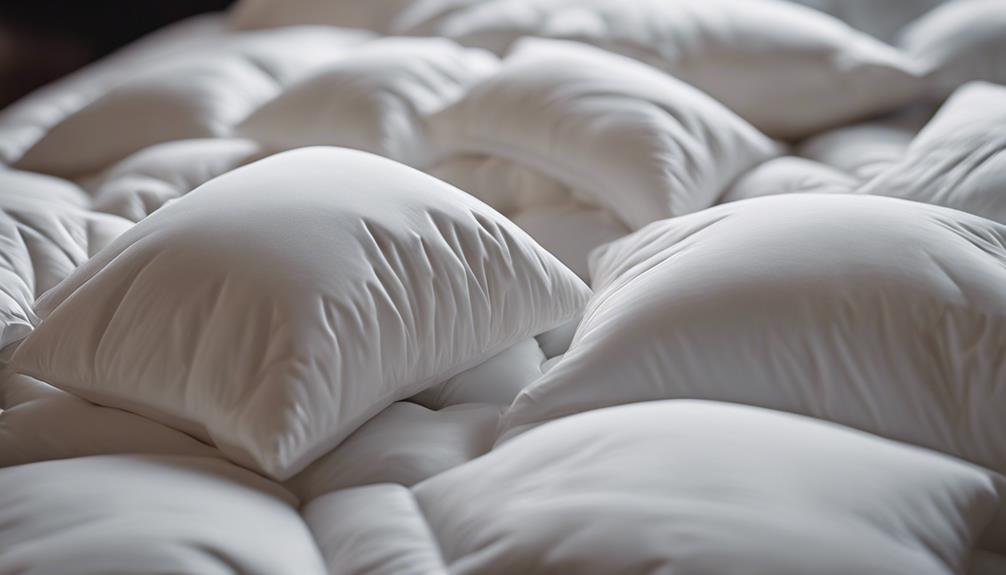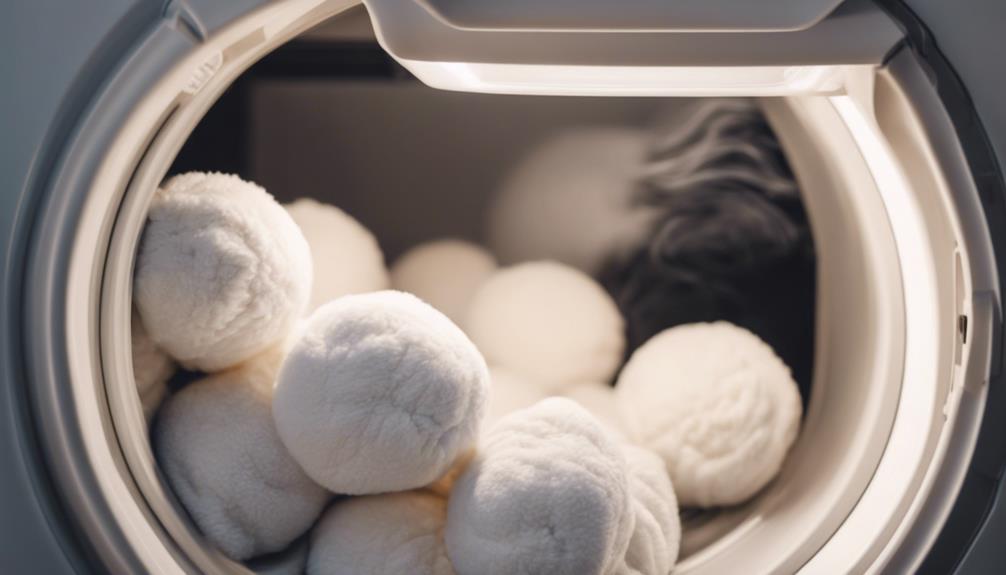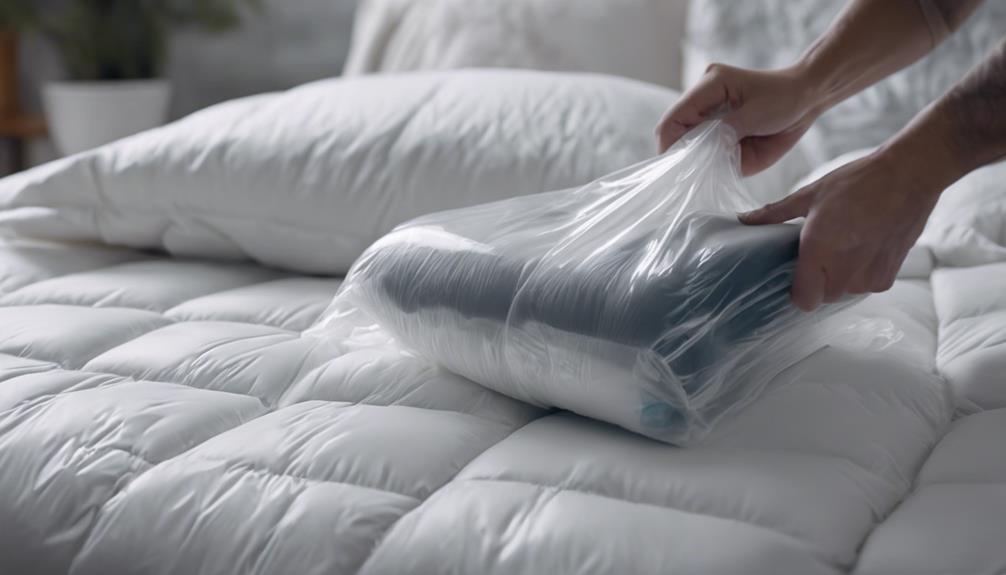When you are deciding on what type of fill to choose for your down comforter, consider goose down for the highest level of warmth. Goose down has larger clusters and higher fill power, providing exceptional insulation for premium quality and ultimate coziness. On the other hand, duck down offers a more affordable option with good warmth and practicality suitable for moderate climates. The fill power and weight are important factors that determine the insulation levels and overall comfort of the comforter. It is crucial to understand these differences in order to select the best fill that aligns with your preferences and climate requirements. Delving deeper into these details will enable you to make an educated choice for your perfect down comforter.
Key Takeaways
- Goose down offers superior warmth and insulation due to larger clusters and higher fill power.
- Duck down is a budget-friendly option with good insulation for moderate climates.
- Fill power is crucial for insulation quality, with higher fill power providing better warmth.
- Fill weight influences insulation level and overall coziness of the comforter.
- Personal preference and climate considerations play a role in selecting the best fill for a down comforter.
Goose Down for Superior Warmth
When weighing unparalleled warmth in a down comforter, choosing goose down with its larger clusters is a wise choice. Goose down is renowned for its ability to provide superior warmth compared to duck down. The larger clusters in goose down create more air pockets, enhancing insulation and resulting in better heat retention. This makes goose down comforters not only luxurious but also highly efficient in keeping you warm and cozy.
One significant factor to take into account when examining goose down comforters is the fill power. Higher fill power options in goose down indicate premium quality and increased warmth. Fill power refers to the measure of the down's loftiness and its ability to trap air, which translates to better insulation. For those who prioritize warmth and comfort in their bedding, goose down with higher fill power is an excellent choice. It's no wonder that goose down remains a popular option for those seeking the highest level of warmth and comfort in a down comforter.
Duck Down for Budget-Friendly Option
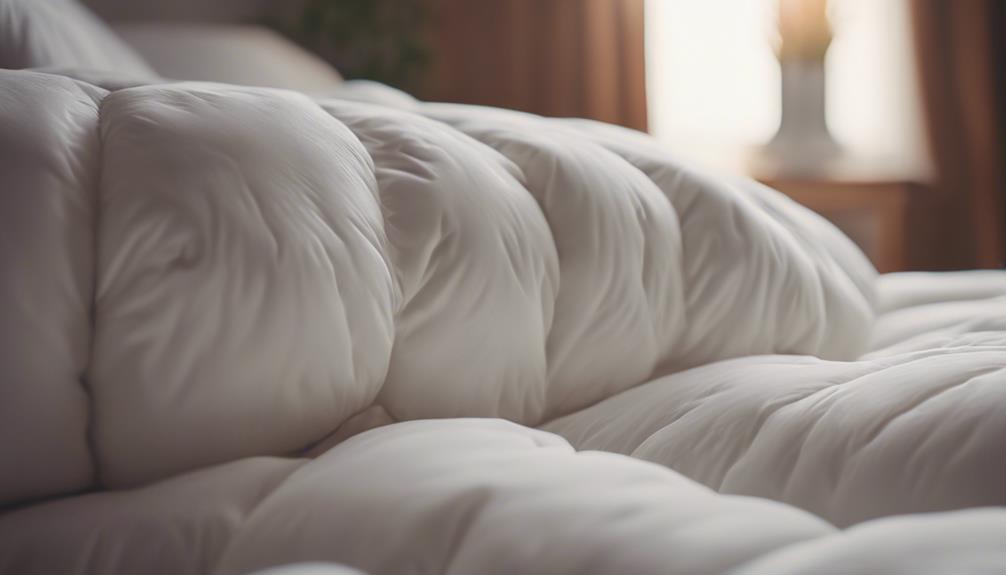
For those seeking a budget-friendly option in down comforters, duck down presents a practical and cost-effective choice. Duck down, derived from smaller clusters found on ducks, offers good insulation and warmth suitable for moderate climates. While not as luxurious as goose down, duck down remains a practical alternative that provides coziness without breaking the bank. Consider duck down when looking for a comfortable and affordable bedding option.
| Aspect | Details |
|---|---|
| Comforter | Duck down is a budget-friendly option. |
| Fill power | Provides good insulation and warmth. |
| Duck down | Derived from smaller clusters on ducks. |
| Cost-Effective | Practical choice for those on a budget. |
Fill Power for Increased Insulation
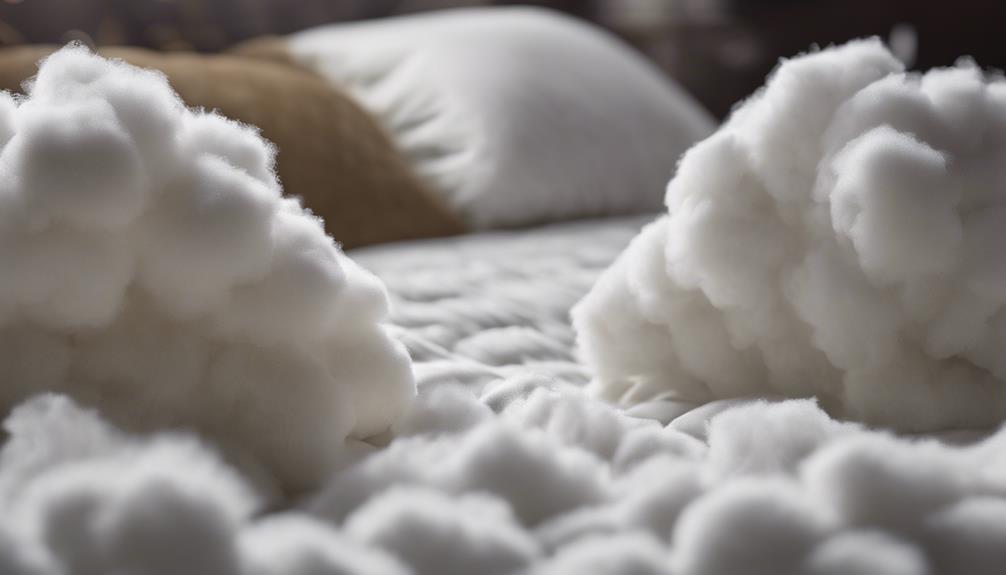
Fill power is vital for boosting insulation in a down comforter. Higher fill power means better warmth and durability.
It's important to select the right fill power to guarantee ideal comfort and coziness in your bedding.
Insulation and Fill Power
Understanding the significance of fill power in a down comforter is essential for selecting the right level of insulation and warmth.
When considering insulation and fill power, here are some key points to keep in mind:
- Fill power determines the quality of insulation provided by the down fill.
- Higher fill power results in increased warmth and better heat retention.
- Fill power is measured in cubic inches per ounce, with higher values indicating superior quality.
Down Comforter Warmth
When choosing a down comforter for maximum warmth, consider the fill power as it directly impacts the insulation level and overall coziness. Fill power determines the warmth level of a down comforter, with higher fill power providing increased insulation. Peak warmth is typically achieved with fill powers ranging from 600 to 700, but in colder climates, options with 700+ fill power may be more suitable. Higher fill power results in larger down clusters that trap more air, enhancing the comforter's insulation capabilities. It also influences the softness, loftiness, and overall warmth of the comforter. Customizing the warmth level of your down comforter involves selecting the right fill power to meet your specific needs.
| Fill Power Range | Warmth Level | Best Use Case |
|---|---|---|
| 400-599 | Moderate warmth | Mild climates |
| 600-699 | Peak warmth | All-season comfort |
| 700+ | High warmth | Cold climates |
Choosing the Right Fill
For best warmth and enhanced insulation in a down comforter, consider the fill power as a key determinant of its quality. When choosing the right fill, keep these points in mind:
- Higher Fill Power: Choose 700+ fill power for peak warmth in colder climates.
- Balanced Performance: A fill power of 600-700 strikes a good balance between warmth and weight.
- Quality Assurance: Fill power influences the loftiness and softness of the comforter, ensuring a top-notch product.
Fill Weight for Added Warmth
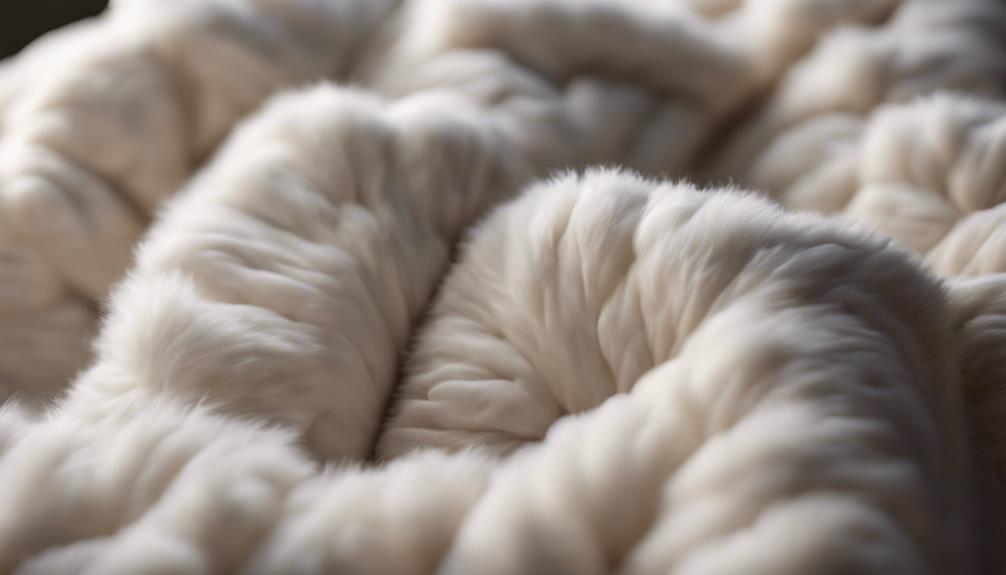
To enhance the warmth of your down comforter, consider the fill weight as a key factor influencing its insulation level. Fill weight refers to the amount of down inside the comforter shell. Higher fill weight provides more insulation, making the comforter warmer. It plays a significant role in determining the overall heaviness and coziness of the comforter. The fill weight can vary depending on the size and density of the comforter. Choosing the right fill weight is essential for achieving the desired level of warmth.
| Fill Power Measures | Higher Fill Power | Fill Material |
|---|---|---|
| 600-700 | Warmer comforter | Duck down |
| 700-800 | Increased warmth | Goose down |
| 800+ | Maximum insulation | Eiderdown |
Personal Preference for Fill Choice

Considering personal preferences and comfort needs, selecting the ideal fill choice for a down comforter plays a significant role in enhancing one's sleeping experience. When it comes to fill choice, factors like fill power and personal preference are key considerations.
Here are three essential points to help guide your decision:
- Fill Power: Opting for a high fill power, such as 700+, guarantees superior warmth, particularly beneficial in chilly climates.
- Personal Preference: Your personal preferences, such as whether you prefer a lighter or heavier comforter, should influence your fill choice.
- Climate Consideration: Depending on the climate you live in, you may lean towards goose down for superior warmth or duck down for a more budget-friendly option with good insulation.
Quality Considerations for Down Comforter
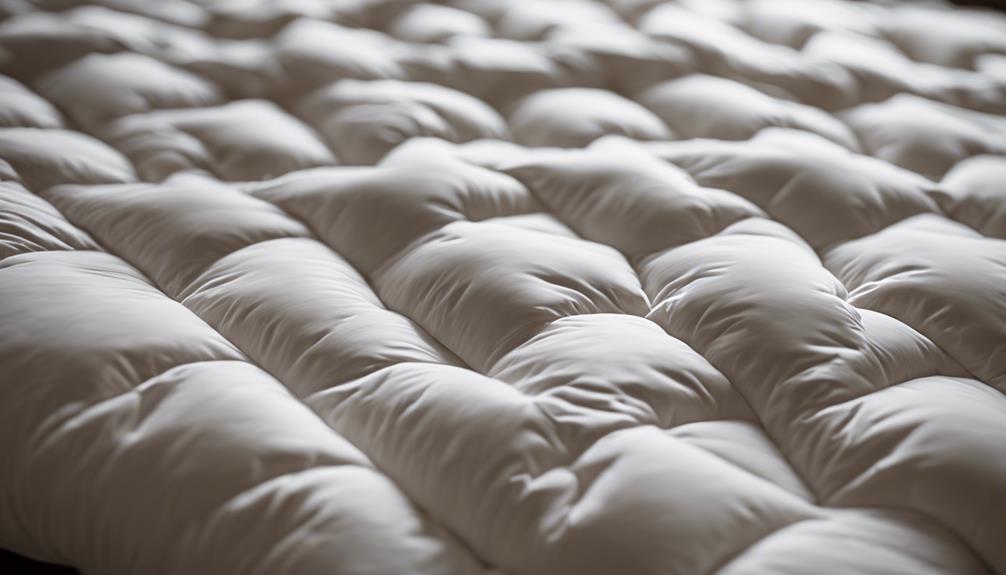
When considering the quality of a down comforter, key points to evaluate include:
- The down fill power
- The quality of the fill material
- The type of construction stitching used
These aspects directly impact the warmth, comfort, and longevity of the comforter.
Understanding these quality considerations can help in selecting a down comforter that meets your needs and expectations.
Down Fill Power
Typically, higher fill power in down comforters signifies superior quality, offering increased loft and insulation for enhanced warmth. When considering down fill power for your comforter, keep in mind these essential points:
- Fill power directly influences the softness, durability, and longevity of a down comforter.
- The size of down clusters in higher fill power options results in better loft and overall comfort.
- Fill power measurement in cubic inches per ounce reflects the fluffiness and insulating ability of the down.
Understanding these aspects of fill power can help you make an informed decision when selecting a down comforter that meets your warmth and comfort needs.
Fill Material Quality
Moving from the discussion on down fill power, the quality of fill material in a down comforter plays a significant role in determining its overall performance and comfort level.
The higher the fill power, such as 700+ fill power, the better the quality for colder climates. Goose down is considered top-tier due to its larger clusters and higher fill power, providing exceptional softness, warmth, and durability. In contrast, duck down, while more affordable, is better suited for warmer climates due to its smaller clusters and lower fill power.
White down is a popular choice for blending with other materials in down comforters, offering a versatile and luxurious option. Ultimately, fill power directly impacts the quality of the fill material and the overall experience of using a down comforter.
Construction Stitching Types
For the best comfort and durability in a down comforter, selecting the right construction stitching type is essential. When considering the stitching types for your down comforter, here are three key factors to keep in mind:
- Baffle box stitching creates 3D boxes for even fill distribution.
- Gusseted stitching adds extra loft, providing a luxurious feel.
- Diamond quilt stitching prevents fill clumping, ensuring lasting quality.
The stitching pattern used in constructing a comforter directly impacts its comfort, durability, and overall quality. Whether you prefer baffle box design, gusseted stitching, or diamond quilt patterns, each type offers unique benefits to enhance your sleeping experience.
Warmth Level Selection Guide
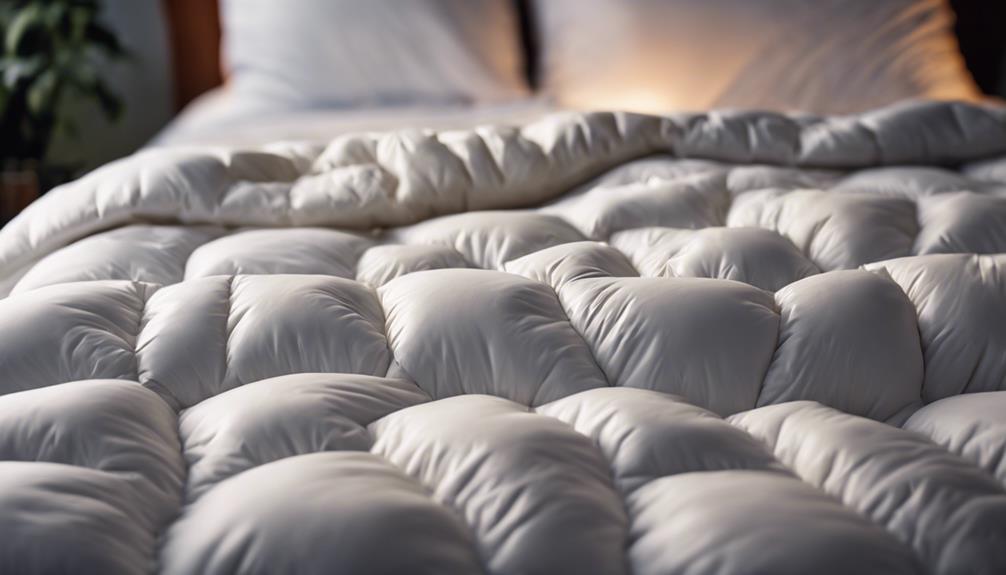
When selecting the warmth level for your down comforter, consider the fill type and fill power to guarantee maximum comfort and insulation. Goose down is excellent for superior warmth in cold climates due to its larger clusters, while duck down, with smaller clusters, offers a more budget-friendly option suitable for milder temperatures.
The fill power of the down, typically ranging from 600-700, indicates the insulation level and overall warmth of the comforter. Additionally, fill weight plays a vital role in determining the coziness of the comforter, with higher weights providing increased warmth.
It's important to choose the fill type and warmth level based on personal preferences and the temperature of the room at night. By understanding the relationship between warmth level, fill power, and fill weight, you can select a down comforter that meets your specific comfort needs for a restful night's sleep.
Budget-Friendly Fill Options
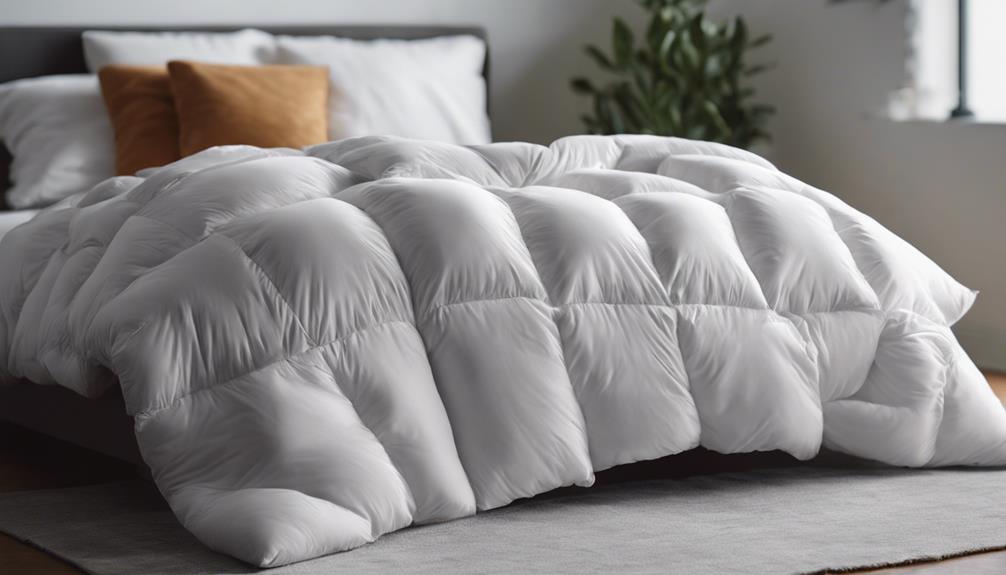
Duck down emerges as a cost-effective yet quality option for those seeking budget-friendly fill choices for down comforters. When looking for a down comforter fill that won't break the bank, consider these three key points about duck down:
- Affordability: Duck down is a more budget-friendly option compared to other types of down fill, making it an attractive choice for those on a tighter budget.
- Insulation: Despite its lower fill power than goose down, duck down still provides good insulation, keeping you warm and cozy during colder nights.
- Quality: Opting for duck down doesn't mean compromising on quality. It offers a balance between affordability and comfort, making it a popular choice for many.
Choosing duck down for your down comforter can be a practical and cost-effective decision without sacrificing the warmth and comfort you desire.
Factors Influencing Fill Selection

When selecting the fill for your down comforter, it's crucial to take into account the significance of fill power. Higher numbers indicate better quality and insulation.
Additionally, bear in mind any material allergies you may have to guarantee a comfortable experience.
Fill Power Importance
Fill power plays an essential role in determining the quality and performance of a down comforter.
- Higher fill power leads to better insulation and longevity.
- The warmth and lightness of the comforter are influenced by fill power.
- Fill power measurement is expressed in cubic inches per ounce.
Choosing the right fill power is vital for achieving the desired warmth and comfort in a down comforter. The power of the fill, along with the fill weight and fill type, directly impacts the overall quality and performance of the comforter.
Material Allergies Consideration
Considering potential material allergies is a critical aspect when selecting the appropriate fill for a down comforter. If you have sensitivities to natural down, opting for hypoallergenic options like down alternative fills can be a wise choice. Materials such as PrimaLoft® and LoftAIRE™ are excellent alternatives for individuals with allergies to traditional down. These synthetic fills are often non-allergenic while providing similar warmth and comfort.
When shopping, be sure to check product labels for hypoallergenic claims and certifications to confirm the fill meets your needs. Consulting with a healthcare provider if you have severe allergies is advisable to select the best fill for your comforter. Remember, prioritizing hypoallergenic options can help you enjoy a cozy night's sleep without any discomfort.
Durability and Maintenance
To guarantee the longevity and performance of a down comforter, selecting a durable fill is crucial. Higher fill power down comforters are more durable and longer-lasting due to the quality of the down clusters.
Proper care and maintenance, such as dry cleaning or following manufacturer instructions, can extend the lifespan of the fill in a down comforter. Quality fill like goose down is more resilient to compression and clumping, maintaining the comforter's loftiness over time.
Choosing a fill with higher fill power and quality establishes durability, allowing the comforter to retain warmth and fluffiness. Proper maintenance practices further enhance the longevity of the fill, contributing to the overall quality and performance of the down comforter.
Summary of Best Down Comforter Fill
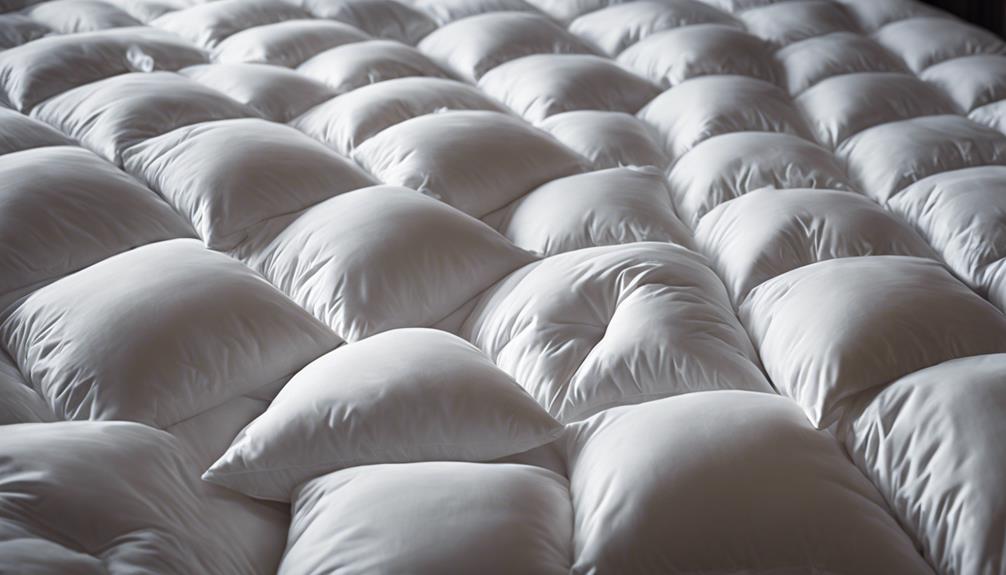
When selecting the best down comforter fill, it is important to prioritize goose down for its superior warmth and larger clusters. Goose down is renowned for its ability to provide excellent insulation, especially in chilly climates. Higher fill power, such as 700+, offers top-tier quality for those seeking maximum warmth. Fill powers ranging from 600-700 are ideal for most sleepers, catering to a variety of preferences. Choosing a down comforter with a higher down percentage guarantees a luxurious feel and superior quality. Additionally, white down is a versatile option, perfect for blending with other materials while maintaining a high level of quality. To summarize the best down comforter fill options, consider the following table:
| Fill Type | Benefits |
|---|---|
| Goose Down | Superior warmth, large clusters |
| Higher Fill Power | Top-quality insulation for cold weather |
| White Down | Quality, versatility |
| Down Percentage | Indicates quality, luxurious feel |
| 600-700 Fill Power | Best warmth for various preferences |
Frequently Asked Questions
What Is the Difference Between 700 and 800 Fill Down Comforter?
When comparing 700 and 800 fill power down comforters, the main difference lies in warmth and insulation.
An 800 fill power comforter offers superior warmth and loft, ideal for extremely cold temperatures.
On the other hand, a 700 fill power comforter still provides excellent insulation suitable for colder climates.
Choosing between the two depends on personal warmth preferences and the climate where the comforter will be used.
What Is the Best Filling for a Comforter?
When choosing a comforter filling, consider factors like warmth, quality, and budget. Goose down with higher fill power, like 700+, offers excellent insulation and durability. Duck down is a more affordable option with decent warmth. Both types have pros and cons to match personal preferences.
Understanding fill power and weight helps in making the best choice for your comforter needs. It's important to balance quality and comfort for a cozy night's sleep.
What Is the Difference Between 650 and 700 Fill Down?
The difference between 650 and 700 fill power down lies in the amount of air trapped within the down clusters. Higher fill power like 700 results in larger, more resilient down clusters. These clusters provide superior loft and warmth for colder climates compared to 650 fill power, which offers good insulation for moderate warmth.
Choosing between 650 and 700 fill power depends on desired warmth levels and climate conditions.
Is 600 Fill Down Warm in a Comforter?
600 fill down is indeed warm in a comforter, providing a cozy night's sleep without overheating. Our down comforter with 600 fill power offers excellent insulation for most climates.
The balance of warmth and breathability makes it a popular choice. Expect a lightweight yet snug experience with this fill power.
Does Thread Count Affect the Quality of the Fill in a Down Comforter?
When it comes to down comforters, the thread count for comforters is an important factor in determining the quality of the fill. A higher thread count usually means a tighter weave, which can prevent feathers from poking through. This ultimately leads to a more comfortable and durable comforter.
:Can the Best Fill for a Down Comforter Also Provide Comfort in Recliners?
When considering the best fill for a down comforter, it’s important to also think about its use in the best recliners for 2024. The fill should provide comfort and insulation while sitting, allowing you to relax and stay warm. Look for a versatile fill that can enhance comfort in both your comforter and recliner.
Conclusion
To sum up, the best fill for a down comforter ultimately depends on personal preference and budget. Goose down offers superior warmth, while duck down is a more budget-friendly option. Consider fill power for increased insulation and fill weight for added warmth. Use our warmth level selection guide to find the perfect comforter for you.
Factors influencing fill selection include warmth needs, budget constraints, and desired comfort level. Choose wisely to guarantee a cozy night's sleep.
